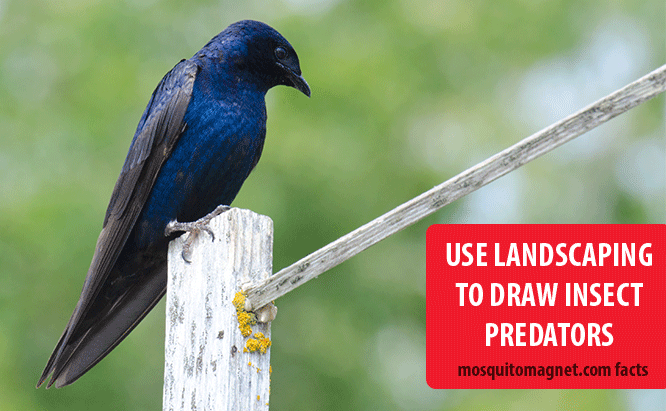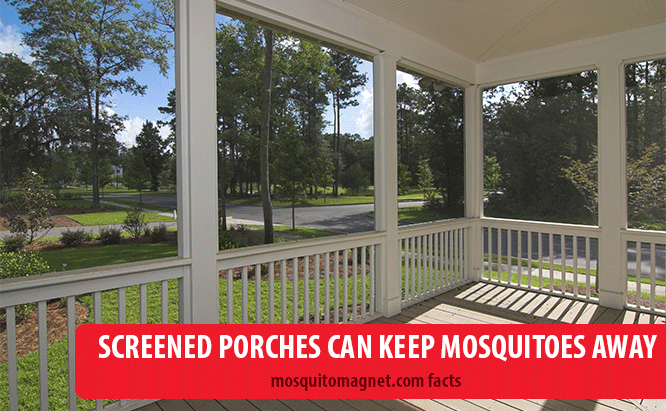
It’s common knowledge that mosquitoes use stagnant water to incubate their eggs. You also probably know that getting rid of things that trap water in your yard, like old tires, can cut down on the number of mosquitoes.
What’s not so well known is that there is another way to keep your local mosquito population in check: With Landscaping. By paying attention to certain aspects of your lawn and landscaping, you’ll have more in your arsenal in the battle against mosquitoes.

ELIMINATE WET SPOTS
While it’s obvious that a mosquito can lay eggs in the stagnant water inside an old tire, it may not be so obvious that they can also lay eggs where they’ve always laid eggs – in natural areas that accumulate water. Keep an eye out for places on your property that have standing water, including mud puddles, tire tracks and poorly drained low areas. Eliminate them by adding a layer of stone, cover that with topsoil and then reseed if needed.

REMOVE WIND SCREENING FEATURES
Though they have wings, mosquitoes are not strong or skillful fliers. These delicate insects love calm, humid days when the air is heavy and their little wings allow them to do exactly what they intended to do. Even the gentlest breeze can toss them around and make life in the air more than difficult. Many yards have features that inadvertantly block the wind, including shrubs, trees with heavy foliage, fences and walls. To fight back against a mosquito onslaught, you can remove these features, which will allow wind to blow across your property without obstruction. The result? More trouble for mosquitoes!

ADD MOSQUITO REPELLENT PLANTS
The most colorful way to battle mosquitoes is to add plants that mosquitoes hate. These plants – including alliums, mums, marigolds, mint, basil and floss – can be placed around your patio, porch or gazebo. The aromas from these plants cause trouble for mosquitoes – some confuse them and others simply repulse them – which is enough to keep them away from you. Still, these plants don’t always emit these unfriendly smells, so it’s good to add another layer of mosquito protection.

HELP MOSQUITO PREDATORS
A number of mosquito-eating animals can add to your mosquito control efforts. Look for ways to help these animals by offering them the habitat they need to survive. Entice bats into your yard with bat boxes. Purple martins need houses built just for them. Spiders are a big help too, so don’t go overboard removing their webs. Most of all, remember there are very few animals that exclusively hunt mosquitoes, so aim for a tag-team approach!

MULCH WITH CEDAR
The aroma of cedar has long been used to repel insects including termites, ants, moths and others. Add mosquitoes to that list, too. The smell of cedar comes from the oil trapped in the wood. The scent will diminish over time, indicating that the oil is drying up. At that point, the mulch will no longer function as an insect repellent. Apply this mulch around your outdoor gathering spots and in flower beds to stop mosquitoes from sheltering among them.

ADD CIRCULATORS TO WATER FEATURES
Mosquito eggs can only grow when submerged in stagnant or poorly circulating water. If you have a pond or other water feature on your property, add a fountain, filter, pump or other device to make sure the water gets moving. Since mosquito larvae have no way to swim or protect themselves from strong (or even moderate) currents, they require stagnant water for their development.

PLACE A CO2 MOSQUITO TRAP
One of the best options for keeping mosquitoes away from your property is to add a CO2 mosquito trap. These devices exude an attractant that draws mosquitoes to the trap and away from people and pets. As the mosquitoes investigate this alluring scent, they’re vacuumed inside the device, become trapped and then die of dehydration. These traps are an effective way to reduce mosquitoes on your property without using chemical sprays or repellents, though when used in conjunction with repellents the effect is even greater.

MOW THE LAWN & REMOVE TALL WEEDS
During the heat of the day, mosquitoes will retreat into foliage to avoid dehydrating. That means the weeds on the outskirts of your property could be a haven for mosquitoes. Tall weeds aren’t your only problem though – even an unmowed lawn can provide safety for a mosquito. After all, most mosquitoes are barely ¼ of an inch long, so two inches of grass offers plenty of protection.

ADD OVERHEAD FANS
For your outdoor entertainment areas and porches, consider adding fans near these areas of high human activity. The strong breeze provided by a fan is enough to drive mosquitoes away and keep them from landing on their victims. Fans can be installed overhead to keep them out of the way. An oscillating fan is far better than a stationary fan for repelling mosquitoes since it creates irregular air flow and becomes difficult for a mosquito to navigate.

INSTALL SCREENS ON PORCHES
Along with adding fans to your porch, installing screens along a porch can be highly effective at limiting your exposure to mosquitoes. Screens use mesh that is so tightly woven that mosquitoes (and many other insects) can’t get through. Screening in porches, gazebos and other structures allows you to be “outside” without worrying about biting insects, however, these screens can trap heat and deaden breezes.
TAKING CONTROL OF YOUR YARD
If you’ve got a real mosquito problem on your property then get help and ideas for removing them by joining the Mosquito Magnet® Facebook community, where our mission is to get rid of these annoying and dangerous insects. If you’re interested in a CO2 mosquito trap, then subscribe to the Mosquito Magnet® E-Newsletter to learn more about our traps, get articles on how to battle mosquitoes and news about the developing mosquito threat in North America.



